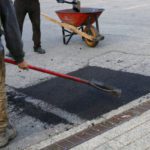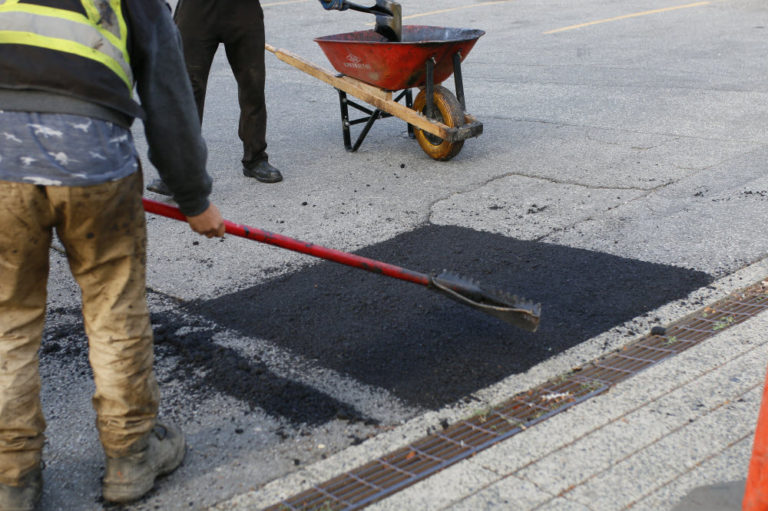Permanent Pothole Repair: Pavement covers thousands of square miles of land in the States — and all of that pavement needs periodic maintenance to keep the country moving ahead. Potholes are one of the most common paving challenges, especially in asphalt. Potholes are not only unsightly, but they can also be dangerous, as they can cause injury to drivers as well as vehicle damage.
How are potholes formed?
Several factors contribute to potholes, including the expansion and contraction of water  after it has penetrated the ground beneath the pavement. As heavy vehicles pass over the weak spot in the road, sections of the pavement fracture, causing the material to break down under the weight of the traffic, resulting in the formation of the pothole.
after it has penetrated the ground beneath the pavement. As heavy vehicles pass over the weak spot in the road, sections of the pavement fracture, causing the material to break down under the weight of the traffic, resulting in the formation of the pothole.
If your asphalt pavement has formed a pothole, you must fix it immediately to prevent further issues. But what if it is too cold outside to make any repairs?
Freeze-thaw cycles are among the biggest reasons for potholes, so you can not make a lasting pothole repair in the middle of December. The outside temperature should be around 50°F and 90°F for asphalt to cure correctly — but do not panic if it is cold outside as temporary pothole repairs are available.
Temporary pothole repair
It is not always possible to make a permanent pothole repair right away. In some cases, you may need a temporary asphalt patch until you are ready for a lasting fix.
You cannot permanently fix the potholes all the time due to two primary factors — temperature and compaction.
Hot-mix asphalt requires certain temperature thresholds to set and compact correctly. When poured into a cold environment, it is impossible to properly compact hot-mix asphalt.  Because improper pouring results in asphalt that can be easily chipped and damaged, you should never use hot-mix asphalt for pothole repair unless temperatures have been consistently above freezing for many days.
Because improper pouring results in asphalt that can be easily chipped and damaged, you should never use hot-mix asphalt for pothole repair unless temperatures have been consistently above freezing for many days.
While hot-mix asphalt repairs may be outside your area of expertise, most homeowners are capable of performing temporary cold-mix asphalt repairs. Here are the steps you must follow to fix a pothole with cold-mix asphalt.
- Remove any loose debris from the pothole using a broom.
- Fill the pothole with cold-mix asphalt — pour the asphalt about half inches above the surface.
- Compact the asphalt using a steel tamper.
- Though a patch can handle regular traffic almost immediately, it is recommended that you wait at least three weeks before turning wheels or parking cars on top of a cold patch.
Permanent pothole repair
You can fix a pothole permanently if Mother Nature grants you warm temperatures (well above freezing for at least 48 hours). In contrast to a cold-patch repair, a permanent pothole repair is complex and often necessitates the expertise of a local asphalt contractor.
The contractor’s responsibility is to remove any temporary patches, clear the pothole of any loose debris, pour a specially formulated hot-asphalt mix into the pothole, and compact it to the desired density. After a few hours, your asphalt will look and feel brand new.
Pothole repairs done right!
 Cold-mix asphalt should be used for short-term repairs during the colder months. Cold patches do not last for long and may require subsequent permanent fixes. If you want to repair the pothole effectively and for the long term, we recommend complete removal and replacement patch of the asphalt around the pothole. If you fix your potholes the right way, you will be able to get the most out of your asphalt pavement.
Cold-mix asphalt should be used for short-term repairs during the colder months. Cold patches do not last for long and may require subsequent permanent fixes. If you want to repair the pothole effectively and for the long term, we recommend complete removal and replacement patch of the asphalt around the pothole. If you fix your potholes the right way, you will be able to get the most out of your asphalt pavement.
Hopefully, you have now understood the difference between temporary and permanent pothole repairs. Contact your local asphalt contractor today for more information about asphalt repairs and maintenance!
Address
Commonwealth Paving, 136 Outerloop, Louisville, Kentucky 40214
Phone: 502-459-7283, Fax: 502-456-2678
Opening Hours
| Monday | 9:00 AM – 5:00 PM |
| Tuesday | 9:00 AM – 5:00 PM |
| Wednesday | 9:00 AM – 5:00 PM |
| Thursday | 9:00 AM – 5:00 PM |
| Friday | 9:00 AM – 5:00 PM |
| Saturday | Closed |
| Sunday | Closed |







